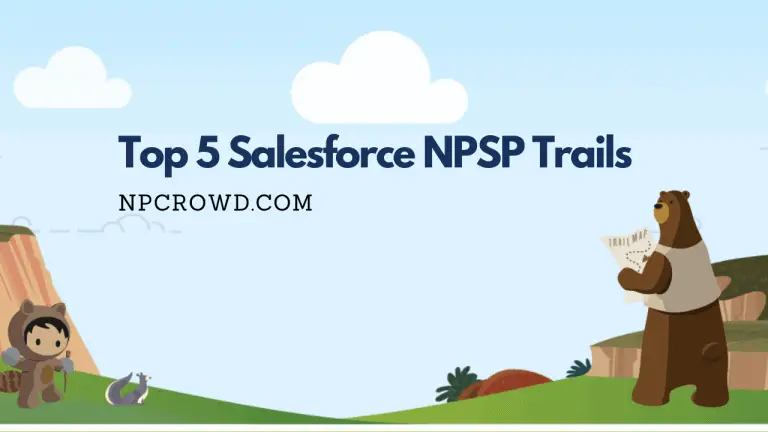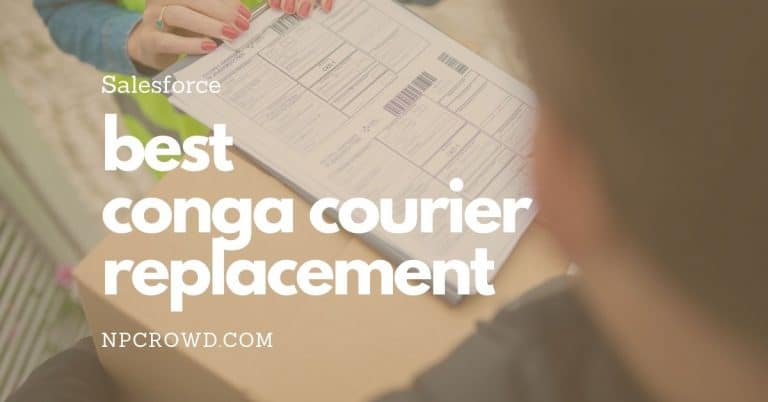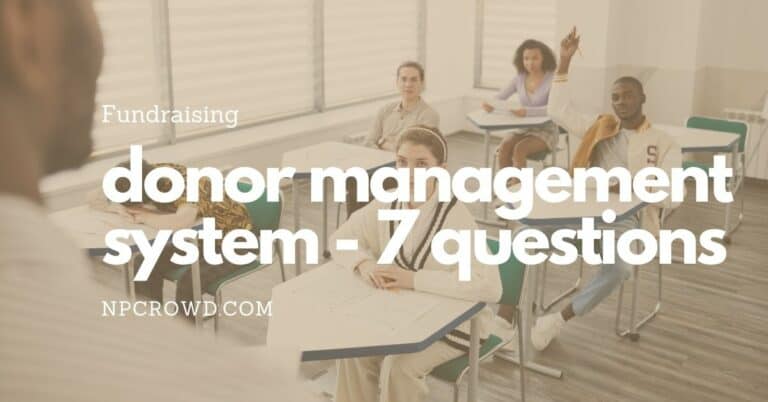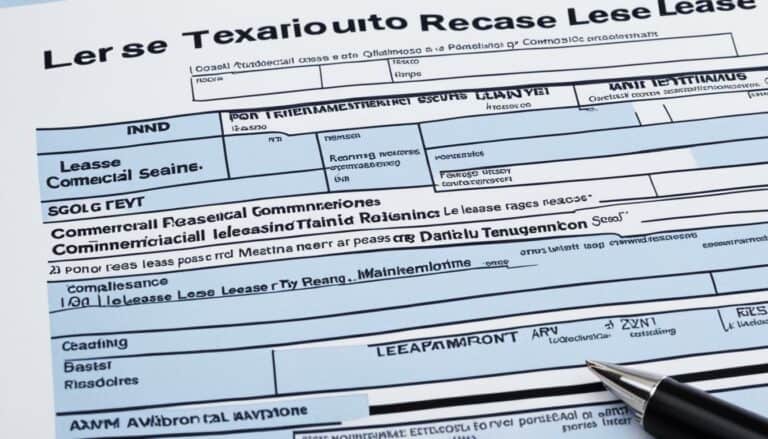Enhancing Program Management in Nonprofits with Salesforce
Disclaimer: This post may contain affiliate links. These links, if used and purchases made, we may earn a small commission. These affiliate programs do not impact the recommendations we make or the resources we refer you to. Our focus is on providing you the best resources for your nonprofit journey.
The Salesforce Nonprofit Program Management offers nonprofits a centralized platform to manage their operations and engage with donors, volunteers, and other stakeholders. By leveraging the power of Salesforce, nonprofits can enhance their efficiency, improve data management, and ultimately make a greater impact in their communities. This article explores why nonprofits should use Salesforce for program management, key features of Salesforce for nonprofit program management, best practices for implementing Salesforce in nonprofit program management, and success stories of nonprofits using Salesforce for program management.Key Takeaways
- Salesforce Nonprofit Program Management provides a centralized platform for nonprofits to manage operations and engage with stakeholders.
- Using Salesforce for program management can enhance efficiency and improve data management in nonprofits.
- Key features of Salesforce for nonprofit program management include customizable data fields and objects, automated workflows and processes, integrated communication tools, and reporting and analytics capabilities.
- Best practices for implementing Salesforce in nonprofit program management include engaging stakeholders, defining goals, designing a user-friendly interface, providing adequate training and support, and regularly evaluating and improving.
- Success stories of nonprofits using Salesforce for program management showcase the benefits and impact of implementing Salesforce in nonprofit organizations.
Why Nonprofits Should Use Salesforce for Program Management

Streamlining Data Collection and Analysis
Streamlining data collection and analysis is a crucial aspect of program management for nonprofits. By replacing sticky notes, spreadsheets, and fragmented digital systems with a centralized repository, Salesforce provides a single source of truth for all your organization’s data. This holistic view empowers your staff by providing a comprehensive view of contacts, appointments, programs, services, donations, events, and resources. With all data consolidated, organizations can harness the power of analytics to track fundraising against monthly goals, generate program reports for funders, and gain valuable insights that propel your mission forward.
Improving Communication and Collaboration
Improving communication and collaboration is crucial for the success of any nonprofit organization. With Salesforce, you can centralize all communication channels and collaborate more effectively with your team members. By replacing sticky notes, spreadsheets, and fragmented digital systems with a centralized repository, Salesforce provides a single source of truth that empowers your staff. This unity facilitates better collaboration and fosters stronger relationships among team members.
In addition, Salesforce enables you to track fundraising against monthly goals and generate program reports for funders. With all data consolidated, you can harness the power of analytics and gain valuable insights that propel your mission forward. By identifying operational efficiencies, Salesforce allows for smarter distribution of work and simplifies tasks such as board meeting information management.
To enhance communication and collaboration even further, Salesforce provides integrated communication tools. These tools enable effective communication, help volunteers connect with relevant opportunities, and organize community events to involve the community in your mission. Strong engagement leads to increased support and sustainable relationships, ultimately allowing you to have a higher impact.
In summary, Salesforce enhances communication and collaboration in nonprofits by centralizing communication channels, providing valuable insights through analytics, and offering integrated communication tools. By leveraging these features, nonprofits can streamline their operations, improve team collaboration, and ultimately achieve their mission more effectively.
Enhancing Donor and Volunteer Management
Volunteer management is a crucial aspect of any nonprofit organization. It allows you to efficiently and easily track volunteer engagement, engagement with major donors, program participants, or any other series of assignments. By implementing the Salesforce Nonprofit Program Management, you can streamline your volunteer management processes and ensure that your volunteers are effectively engaged.
One way to enhance volunteer management is by using the customizable Constituent Relationship Management (CRM) feature of Salesforce. This allows you to keep detailed records of volunteers, track their activities and contributions, and segment them for more targeted outreach.
In addition, the Salesforce Nonprofit Program Management provides tools for creating and managing fundraising campaigns. This enables you to not only engage volunteers but also leverage their support to raise funds for your organization’s initiatives.
To further optimize your volunteer management, consider utilizing the grant and fund management feature of Salesforce. This allows you to track the impact of volunteer efforts on grant-funded projects and effectively manage the funds allocated to these initiatives.
Remember, volunteer management is not just about tracking hours and assignments. It’s about building relationships and creating meaningful engagement.
Increasing Efficiency and Productivity
Implementing Salesforce in nonprofit program management can significantly increase efficiency and productivity. By centralizing data and automating workflows, organizations can streamline their processes and eliminate manual tasks. This allows staff members to focus on more strategic and impactful work, rather than spending time on administrative duties.
Additionally, Salesforce’s reporting and analytics capabilities provide valuable insights that can inform decision-making and drive continuous improvement. Nonprofits can track key metrics, measure program outcomes, and identify areas for optimization. With Salesforce, organizations can make data-driven decisions that lead to greater efficiency and productivity.
Key Features of Salesforce for Nonprofit Program Management

Customizable Data Fields and Objects
One important aspect of customizable CRM is the ability to track and manage constituent data effectively. Nonprofits can store and organize information about donors, volunteers, program participants, and other stakeholders in a centralized database. This enables them to have a comprehensive view of their constituents and make informed decisions based on data-driven insights.
By customizing data fields and objects, nonprofits can capture and analyze specific information that is relevant to their programs and initiatives. They can create custom fields to track unique data points and design custom objects to store complex data structures. This flexibility allows nonprofits to adapt Salesforce to their specific needs and ensure that their program management processes are efficient and effective.
To make the most of customizable data fields and objects in Salesforce, nonprofits should:
- Plan and customize: Work with Salesforce experts or consultants to design and configure the CRM system according to your organization’s needs.
- Train and educate users: Provide training and resources to staff members to ensure they can effectively use and benefit from the customized CRM.
- Continuously evaluate and optimize: Regularly review and refine your CRM system to adapt to changing needs and maximize its impact.
Remember, the key is to align Salesforce features with specific business goals and processes. This customization and personalization can tailor Salesforce to fit unique business requirements, including custom fields, page layouts, and workflows. To avoid common mistakes in CRM implementation, it is essential to avoid underestimating training needs. Providing adequate training and support is key to ensuring successful adoption. Additionally, resisting over-customization is important to prevent complications and hinder future updates.
In summary, training and adoption play a vital role in the successful implementation of customizable data fields and objects in Salesforce for nonprofit program management.
Automated Workflows and Processes
Automation tools can be leveraged to streamline processes and ensure data accuracy. It’s crucial to determine which sources of data need to be migrated and which ones can be left behind. Your implementation partner can assist you in making these decisions if you’re unsure where to start. Remember, the data migration and integration process requires the involvement of staff members who interact with the data. Their input and feedback are valuable in ensuring a successful migration. Conduct thorough testing and involve your team in the data migration and integration process to ensure everything is working smoothly. This includes checking the functionality of modifications, integrations, and apps. Your team should also conduct their own tests to ensure that the system is working as expected and aligns with your existing processes. To maintain data quality and integrity, create a data cleansing plan that includes data standardization, deduplication, and validation processes. Automation tools can be leveraged to streamline these processes and ensure data accuracy.
Integrated Communication Tools
Integrated communication tools are a crucial component of program management in nonprofits. With Salesforce, organizations can streamline their communication processes and ensure effective collaboration among team members. The platform provides a centralized repository for all communication channels, including emails, messages, and notifications. This allows staff members to easily access and track all communication related to their programs.
In addition, Salesforce offers features such as task management and calendar integration, which further enhance communication and coordination. Team members can assign tasks, set deadlines, and track progress, ensuring that everyone is on the same page and working towards the same goals.
Furthermore, Salesforce’s integrated communication tools enable seamless communication with clients and stakeholders. Nonprofits can easily send updates, share documents, and gather feedback, ensuring transparency and building trust with their constituents.
Overall, Salesforce’s integrated communication tools empower nonprofits to communicate effectively, collaborate efficiently, and build strong relationships with their clients and stakeholders.
Reporting and Analytics Capabilities
Salesforce enables organizations to track fundraising against monthly goals, generate program reports for funders, and gain valuable insights that propel their mission forward. With the power of analytics, nonprofits can identify operational efficiencies, allowing for smarter distribution of work and simplifying tasks such as board meeting preparation. The system’s usability ensures that insights are accessible and actionable.
By leveraging the platform’s analytical capabilities, organizations can gain a deeper understanding of donor behavior, preferences, and trends. This enables improved donor engagement and personalized communication strategies. Nonprofits can easily analyze and visualize data, such as campaign performance, donor recruitment efforts, and customer retention. These analytics features make data analysis more accessible than ever.
Salesforce for nonprofits also offers reporting capabilities that allow organizations to generate custom reports and dashboards. These reports provide insights into donor behavior, program performance, and operational efficiency, helping nonprofits track the impact of their work and demonstrate it to stakeholders. Additionally, Salesforce’s Enhanced Grant and Fund Management feature enables nonprofits to effectively manage their grants and funds, ensuring that resources are allocated efficiently.
In summary, Salesforce’s reporting and analytics capabilities empower nonprofits to make data-driven decisions, improve donor engagement, and demonstrate the impact of their work. By providing a centralized hub for data and insights, Salesforce streamlines operations and enhances program management in nonprofits.
Best Practices for Implementing Salesforce in Nonprofit Program Management

Engage Stakeholders and Define Goals
Engaging stakeholders and defining clear goals are crucial steps in implementing Salesforce for nonprofit program management. By involving key stakeholders from the beginning, you ensure that their needs and perspectives are considered throughout the process. This collaboration helps build buy-in and support for the implementation, increasing the likelihood of success.
To engage stakeholders effectively, it’s important to communicate the benefits of Salesforce and how it aligns with the nonprofit’s mission and objectives. Highlight how Salesforce can streamline data collection and analysis, improve communication and collaboration, enhance donor and volunteer management, and increase efficiency and productivity.
Once stakeholders are engaged, it’s essential to define clear goals for the implementation. These goals should be specific, measurable, achievable, relevant, and time-bound (SMART). They should align with the nonprofit’s overall strategic objectives and address specific pain points or challenges in program management.
To ensure a successful implementation, consider the following tips:
- Involve stakeholders from different departments and levels of the organization to gather diverse perspectives and ensure buy-in.
- Clearly communicate the benefits of Salesforce and how it addresses the organization’s needs.
- Set realistic timelines and allocate resources accordingly.
- Provide training and support to staff members to ensure they are comfortable using Salesforce.
Remember, engaging stakeholders and defining clear goals are the foundation for a successful Salesforce implementation in nonprofit program management.
Design a User-Friendly Interface
When it comes to designing a user-friendly interface for Salesforce in nonprofit program management, there are a few key considerations to keep in mind. Customization is key, as it allows you to tailor Salesforce to fit the specific requirements of your organization. This includes custom fields, page layouts, and workflows that align with your business goals and processes. By personalizing Salesforce, you can create a solution that is intuitive and efficient for your team to use.
Another important aspect is training and support. Providing adequate training and resources to your staff members is crucial for successful adoption and utilization of Salesforce. This ensures that users are proficient in using the system and maximizes user adoption. Additionally, ongoing support and resources should be available to address any questions or issues that may arise.
To continuously improve your Salesforce implementation, it is important to regularly evaluate and optimize. This involves reviewing and refining your CRM system to adapt to changing needs and maximize its impact. By regularly assessing the functionality and user experience, you can make necessary adjustments and improvements to ensure that Salesforce remains a valuable tool for your nonprofit program management.
Provide Adequate Training and Support
CRM implementation, it is essential to avoid underestimating training needs. Providing adequate training and support is key to ensuring successful adoption. Additionally, resisting over-customization is important to prevent complications and hinder future updates.
In summary, training and adoption play a vital role in the successful implementation of the Salesforce Nonprofit Program Management. By investing in comprehensive training programs and aligning Salesforce with business goals, nonprofits can effectively utilize the program management tools and achieve their potential.
One effective approach is to align Salesforce features with specific business goals and processes. This customization and personalization can tailor Salesforce to meet the unique needs of the nonprofit organization.
Tip: Conduct thorough testing and involve your team in the data migration and integration process to ensure a smooth transition and maintain data integrity.
Regularly Evaluate and Improve
Regular evaluation and adaptation should be carried out to make necessary adjustments and improvements to the functionality and user experience. To avoid common mistakes in CRM implementation, it is important to consider the following:
- Understand business needs and align Salesforce features accordingly
- Customize and personalize Salesforce to fit specific requirements
- Ensure clean and integrated data through effective data management and integration
- Invest in comprehensive user training programs
Remember, testing to ensure that everything is working smoothly. This includes checking the functionality of modifications, integrations, and apps. Your team should also conduct their own tests to ensure that the system is working as expected and aligns with your existing processes.
To maintain data quality and integrity, it’s essential to create a data cleansing plan. This plan should include data standardization, deduplication, and validation processes. Automation tools can be leveraged to streamline these processes and ensure data accuracy.
Additionally, it’s crucial to determine which sources of
Success Stories: Nonprofits Using Salesforce for Program Management

Case Study 1: XYZ Foundation
The XYZ Foundation is a nonprofit organization dedicated to improving access to education for underprivileged children. They implemented Salesforce for their program management needs and have seen significant improvements in their operations. One of the key benefits of using Salesforce is the ability to streamline data collection and analysis. With customizable data fields and objects, the XYZ Foundation is able to track and analyze important metrics related to their programs, such as student enrollment, academic performance, and program outcomes. This data-driven approach has allowed them to make data-informed decisions and allocate resources more effectively.
Case Study 2: ABC Nonprofit Organization
The ABC Nonprofit Organization is a prime example of how Salesforce can revolutionize program management in the nonprofit sector. With Salesforce’s customizable data fields and objects, the organization was able to tailor their data collection and analysis to their specific needs. This allowed them to gain valuable insights into their programs and make data-driven decisions. Additionally, Salesforce’s integrated communication tools improved collaboration among team members and enhanced communication with donors and volunteers. The organization was able to streamline their processes and increase efficiency and productivity.
Case Study 3: DEF Charity
DEF Charity is a nonprofit organization that focuses on providing education and healthcare services to underprivileged communities. With the implementation of Salesforce for program management, DEF Charity has been able to streamline their data collection and analysis processes, allowing them to make data-driven decisions and track the impact of their programs. The customizable data fields and objects in Salesforce have allowed DEF Charity to tailor their data management system to their specific needs, ensuring that they are capturing the right information for their programs. Additionally, the automated workflows and processes in Salesforce have helped DEF Charity improve their efficiency and productivity, reducing manual tasks and freeing up time for their staff to focus on delivering services to their beneficiaries.
Frequently Asked Questions
Why should nonprofits consider implementing the Salesforce Nonprofit Program Management?
The Salesforce Nonprofit Program Management can provide nonprofits with a centralized platform to manage their operations and engage with donors, volunteers, and other stakeholders. By leveraging the power of Salesforce, nonprofits can enhance their efficiency, improve data management, and ultimately make a greater impact in their communities.
What are the key features of Salesforce for nonprofit program management?
The key features of Salesforce for nonprofit program management include customizable data fields and objects, automated workflows and processes, integrated communication tools, and reporting and analytics capabilities.
What are the best practices for implementing Salesforce in nonprofit program management?
The best practices for implementing Salesforce in nonprofit program management include engaging stakeholders and defining goals, designing a user-friendly interface, providing adequate training and support, and regularly evaluating and improving the system.
Can Salesforce Nonprofit Program Management improve donor engagement?
Yes, the Salesforce Nonprofit Program Management offers donor management and fundraising tools that enable nonprofits to track and engage with their donors more effectively. It allows nonprofits to store detailed donor records, track donor interactions, and generate custom reports and dashboards to gain insights into donor behavior.
What are the benefits of implementing the Salesforce Nonprofit Program Management?
The benefits of implementing the Salesforce Nonprofit Program Management include streamlined data management, improved donor engagement, enhanced volunteer management, and increased efficiency and productivity.
How can Salesforce Nonprofit Program Management help with grant and fund management?
The Salesforce Nonprofit Program Management offers nonprofits a comprehensive solution for effective grant and fund management. With its customizable reports, donor and volunteer management tools, and integration capabilities, nonprofits can efficiently manage their funds and make a greater impact in their communities.







